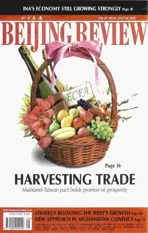Yummy Yunnan
2010-10-16ByVALERIESARTOR
By VALERIE SARTOR
Yummy Yunnan
By VALERIE SARTOR

People everywhere remember food that was made for them by loved ones, a friend once told.
“Often the meal is simple, served without pretense. I discovered this café one day because, as I walked by, it smelled like my grandmother’s kitchen: an aroma of lime, garlic, and ginger tantalized my nose,” said Mei Mei, my Chinese friend from southwest China’s Yunnan Province.
“I guess for many Americans that is why they gravitate to Starbucks: They’re following the smell of coffee,” I replied. “But for me it’s the smell of cardamom. This spice is exotic to Westerners, but my Finnish grandmother always used it for baking.”
“My family was not well off materially when I was young,” Mei Mei said. “But we always had wonderful food, rich in aroma, variety and beauty. Yunnan food is a distinctive regional Chinese cuisine. That’s why I am taking you to this back-alley café to eat.”
We sat down and she ordered, consulting over each choice with the waiter. I admired the bright batik wall hangings and examined the black lacquered tables around the Yunnan restaurant. The ambiance reminded me of Southeast Asia rather than China.
“We are very far from the culinary traditions of Beijing, Shanghai, or even Guangzhou. But we are still in China, because China embraces and encompasses many minority peoples, many cultures,”Mei Mei said. “Yunnan has great diversity—to the south rest Viet Nam, Laos and other Southeast Asian countries. Yunnan foodstuffs are unique. Our culinary traditions do resemble those to the south, as many non-Han Chinese people live in the province.”
Our appetizers arrived. I tasted vegetables flavored with hot chilies, and others marinated in unknown sauces. Small pieces of salty ham delighted me; I discerned the aroma of star anise in a cabbage dish. Then we had sardines served with sticky rice. I told my friend I’d never had this before in China.
“This dish comes from Xishuangbanna, where the majority culture is the Dai people,”Mei Mei said. “Their food is very similar to the northern Thai, or even the Lao people—but it is Chinese.”
When a dish of stewed goat meat, accompanied by tandoor baked flat bread, arrived I learned that another thread of Yunnan culinary tradition comes from the Hui people. The Hui are Muslim. I knew about them, since they live in north China and Xinjiang, where I had lived. Mei Mei explained that for centuries the Hui lived all over China; as traders and business people in the Yuan Dynasty (1279-1368), they traveled everywhere.
“In Yunnan, the Hui are quite famous for their pickles and hot preserves. Try this in your stew, but don’t burn your tongue!” she said, passing me a jar of red pepper sauce. I spooned it onto my plate gingerly, and then began eating a simple cucumber salad flavored with sugar and black vinegar to cool my palate.
Next, we enjoyed small bowls of soup.“This soup comes from another minority people, the Bai. They live around the Erhai Lake region. It’s a home-style pork soup with vegetables, because they, unlike the Hui, raise and eat pigs.”
Yunnan cuisine also has a large and varied repertoire of fish dishes. This is not surprising, as rivers and lakes have always provided a readily available source of food, especially the Lancang River (known as the Mekong outside China). This river begins as a thread high on the Qinghai-Tibet Plateau, and heads down through Yunnan into Southeast Asia. The area around the river is one of the oldest inhabited regions in the world. As time passed, many different peoples have settled, conquered and trickled into the region. All the cultures have specific recipes for fish. Mei Mei had ordered a grilled fish with sauce on the side. When it arrived, she said, “This is a ginger garlic sauce just like my mother’s.” She dipped a small spoon into the sauce and tasted it, and smiled.“Try this—it is made of minced ginger, garlic, bird chilies, a little lime and a kind of fish sauce. Sprinkle it over your fish.”
We ate and ate. When I thought the last dish had come and gone, the waiter came out with one last plate and said, “On the house.”She thanked him. “It’s very simple food, a street snack or dessert,” she explained.“Sweet corn fritters. People eat them all the time at home.” We cleaned the plate and pushed ourselves out of our chairs.
Walking out into the bright sunshine, I asked my friend, “So how do you feel now, Mei Mei?”
“Not homesick anymore,” she replied.“I got my comfort food; I’ll call my mom tonight and chat about what she ate and what I ate today. Life is good.”
The writer is an American living in Beijing
